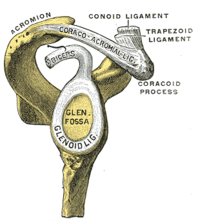
Photo from wikipedia
Objective: This study aimed at improving the discrimination of Prostate Imaging – Reporting and Data System version 2.1 (PI-RADS v2.1) score 3 suspicious prostate cancer lesions using lesion volume evaluation.… Click to show full abstract
Objective: This study aimed at improving the discrimination of Prostate Imaging – Reporting and Data System version 2.1 (PI-RADS v2.1) score 3 suspicious prostate cancer lesions using lesion volume evaluation. Material and methods: Two hundred five PI-RADS v2.1 score 3 lesions were submitted to transperineal MRI/TRUS fusion-targeted biopsy. The lesion volumes were estimated on diffusion-weighted imaging sequence and distributed in PI-RADS 3a (LV < 0.5 mL) and PI-RADS 3b (LV ≥ 0.5 mL) subcategories, using a 0.5 mL cutoff value. Data were retrospectively matched with histopathological findings from the biopsy. Assuming that lesions with LV < or ≥ 0.5 mL were respectively not eligible (benign and indolent PCa lesions) or eligible for biopsy (significant PCa lesions), the diagnostic accuracy of lesion volume in determining clinically significant PCa at biopsy was evaluated using a bi- or multivariate model. Results: About 55.1% and 44.9% of lesions were distributed in subcategories 3a and 3b, respectively. The overall PI-RADS score 3 detection rate was 273%. 3.5% (1.95% of total), and 25% (11.7% of total) significant PCa were found in PI-RADS 3a and 3b subcategory, respectively. The method showed 85.2% sensitivity, 61.2% specificity, 25% positive predictive value, and 96.5% negative predictive value and avoided 55.1% of unnecessary biopsies. The diagnostic accuracy in determining significant PCa at biopsy was 73.2% or 86.5% depending on whether lesion volume was used alone or in combination with prostate volume and patient age in a multivariate model. Conclusion: 0.5 mL lesion volume cutoff value significantly discriminates fusion-targeted biopsy need in PI-RADS v2.1 score 3 lesions and its diagnostic accuracy improves when it combines with prostate volume and age in a multivariate model.
Journal Title: Turkish Journal of Urology
Year Published: 2022
Link to full text (if available)
Share on Social Media: Sign Up to like & get
recommendations!